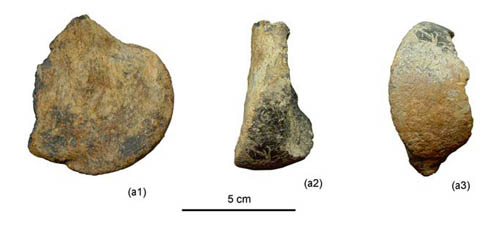| Location: Home > Research > Research Progress |
| Mammalian Fossil First-ever Found in the Cenozoic Deposits of the Lunpola Basin, Northern Tibet |
|
Dr. DENG Tao, Institute of Vertebrate Paleontology and Paleoanthropology (IVPP), Chinese Academy of Sciences, and his research team, found a rhinocerotid fossil in the upper part of the Dingqing Formation at the Lunbori locality in Baingoin County during an extensive and detailed investigation of the stratigraphy and a survey for vertebrate fossils in 2009 and 2010, which is the first mammalian fossil found in Cenozoic deposits of the Lunpola Basin, Northern Tibet, as reported in the journal of Chinese Science Bulletin (No.2-3:261-269) in January 2012. The Lunpola Basin is located on the southern and northern sides of the boundary between Baingoin County and the Shuanghu Special District in northern Tibet. The age of Cenozoic deposits in the Lunpola Basin in northern Tibet has been disputed for many years, primarily because of a lack of fossils with accurate chronological significance. Rhinocerotid fossils are important standard fossils with strict chronological significance for the Cenozoic, and are important indicators of the ecosystems inhabited by mammalian faunas. “The medial condyle of the distal trochlea of the humerus specimen from Lunbori gradually contracts from medially to laterally. The margin of the medial surface of the medial condyle is not prominent, the well-developed medial epicondyle strongly extends posteriorly, and is divided from the articular facet of the medial condyle by a groove”, said DENG Tao, lead author of the study, “These all are typical characteristic for the Family Rhinocerotidae, and it must be a rhinocerotid fossil.” The detailed observations and comparisons show that its medial condyle is wide at the bottom and narrow at the top, the medial collateral ligament fossa is relatively shallow, and the medial collateral ligament tubercle is very weak. The medial part of the upper margin of the medial condyle smoothly connects to the bony surface above, but lacks a clear boundary between them. All of these characteristics are identical with those of Plesiaceratherium. These comparisons imply that the Lunbori specimen is closest to Plesiaceratherium gracile in the Shanwang Fauna from Linqu, Shandong Province, in size and morphology. Plesiaceratherium has previously been found in the late Early Miocene deposits of eastern China and Western Europe. Radiometric dating for the Shanwang Basin in Linqu County, Shandong Province indicates that Plesiaceratherium lived between 18–16 Ma. Thus, the upper part of the Dingqing Formation bearing the fossil Plesiaceratherium was deposited during the late Early Miocene, and the entire Dingqing Formation included Oligocene- Miocene deposits. The vegetation type of the Dingqing Formation was identical to that of the Shanwang Fauna and Plesiaceratherium has been inferred to live in subtropical and warm temperate forests, preferring a warm and humid climate. The correlations and adjustments based on modern alpine vegetation vertical zones in the Himalayas and the Early Miocene global climatic conditions indicate that the highest elevation in the Lunpola Basin at the time of the deposition of the Dingqing Formation could not have exceeded 3170 m a.s.l. The ecological requirements of rhinoceroses through a paleo-temperature adjustment for the Early Miocene indicate that the most reasonable paleo-elevation for Plesiaceratherium is close to 3000 m a.s.l. This work was supported by the Knowledge Innovation Program of the Chinese Academy of Sciences, the National Basic Research Program of China, and the National Natural Science Foundation of China.
Fig.1: Plesiaceratherium sp. (IVPP V 18082) from Lunbori, Baingoin, Tibet (a1, Medial view; a2, anterior view; a3, distal view), in preservation of a medial part of the distal extremity of a left humerus with the complete medial condyle and the residual epicondyle.(Images by DENG Tao) |
